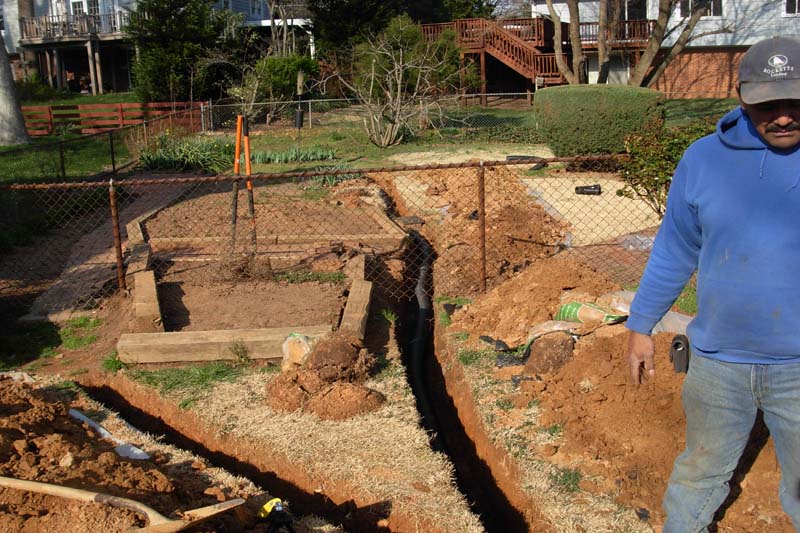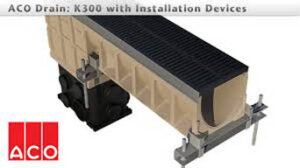Exterior Drainage Contractor Northern Virginia

Fairfax Contractor is an exterior drainage contractor working in northern Virginia. We work with homeowners in Northern Virginia to provide solutions for soggy yards, erosion problems, and grading issues. We have experience solving these complex exterior drainage issues. We are a class A contractor licensed by the state of Virginia and insured for your protection. Some of these exterior drainage problems can create areas in your yard where water pools and do not drain efficiently. Other exterior drainage problems you may be experiencing are creating interior drainage problems because of poor grading and water sitting next to your home. We utilize various techniques to correct the exterior drainage issues you are currently experiencing. Our methods can be very simple or complex, depending on your particular drainage issue. Let one of our drainage consultants come to your home, analyze your exterior drainage problem, and devise a viable solution to correct these problems.
Floor Drains For Use In Diverting Water
 There are many different brands and types of floor drain systems available in the market today. Fairfax Contractor likes to use ACO floor drain systems, these systems allow for a floor drain to be installed in a level area and still divert water. This is done through ACO technology that incorporates grade and each of the floor drain systems. Each one-meter length of floor drain has a built then grade. ACO manufactures 16 different floor drains that can be lined up to move water along a level area effectively. One of the best applications for this floor drain system is at the front of a garage. If your Northern Virginia home has a slanted driveway towards your garage, the garage will inevitably flood. By installing an ACO drain at the edge of your driveway, we can correct this problem. For more information on ACO Floor drains, click this link.
There are many different brands and types of floor drain systems available in the market today. Fairfax Contractor likes to use ACO floor drain systems, these systems allow for a floor drain to be installed in a level area and still divert water. This is done through ACO technology that incorporates grade and each of the floor drain systems. Each one-meter length of floor drain has a built then grade. ACO manufactures 16 different floor drains that can be lined up to move water along a level area effectively. One of the best applications for this floor drain system is at the front of a garage. If your Northern Virginia home has a slanted driveway towards your garage, the garage will inevitably flood. By installing an ACO drain at the edge of your driveway, we can correct this problem. For more information on ACO Floor drains, click this link.
Simple Solutions To Fix A Flooding Yard Northern Virginia
Fairfax Contractor always looks for the easiest solution to fixing a problem such as a flooding Yard. The root causes of this soggy mess may have two simple solutions that can reverse a wet and soggy yard at your Northern Virginia home. One of the easiest solutions available in our proverbial bag of tricks is to install extensions on all of your downspouts. The roof of your home has a tremendous amount of square footage, and when heavy rains come, all of this water is diverted down to your downspouts. If this water from your downspouts is just landing on the splash blocks, it will settle near your foundation walls unless the topography of your lot is sloped in the right direction. An easy fix for this problem would be to extend the leaders on your downspouts away from your home using four-inch solid PVC piping, this will divert the water far from your foundation to a suitable location.
Another simple problem that many homeowners have that is creating soggy areas in the yard is him proper grading of the lot. If your lot is not graded properly, the water will not flow in the direction it needs to be flowing bus standing in areas where you do not want it to be. The grading next to the foundation of your house needs to be a positive slope towards your yard, we can bring in dart and change the topography around your house to keep water from pooling near your foundation.
Exterior French Drain Systems
When your Northern Virginia home has a low spot in the yard that collects water, exterior French drain systems may be the only answer to your problem. Fairfax Contractor understands this time-tested method of building the classic French drain to alleviate water ponding in your wet yard. Typically we will set the grade at the lowest point and extend this line to the area where we want the standing water to move into your yard. At the lowest point, we may be just a few inches below grade extend that line out for, as an example, 100 feet we may need to excavate 25 inches deep to create a quarter of an inch per foot gradient to move water from the lowest point of your yard to a point where it will be safely evacuated. Once the calculations have been made and Miss utilities have been called, we will excavate out a trench that is approximately 18 inches wide and to the depth necessary to create the desired grade. Then we will install a drain box at the low point in your yard to connect a perforated PVC pipe from the drain box to the exit point. The plastic drainpipe will be wrapped in filter fabric to eliminate the pipe from ultimately becoming contaminated by sediment. Then the entire trench will be backfilled with #57 gravel, basically three-quarter inch aggregate. Most of the soil conditions in Northern Virginia are Clay in nature, so one must assume water will always take the path of least resistance. Hence moving from saturated Clay soils into a loosely filled gravel trench is where the water naturally wants to migrate. Once the perforated drain tile picks up this groundwater, it will be divergent to the area where we have designated by design for it to go. This simple technique, commonly known as a French drain system, can be utilized to remove unwanted standing water in your yard quite efficiently. Another way to fix a soggy yard is to install a dry well. For more information on dry wells, click this link.
Flooding Window Wells
Many interior drainage issues are caused by leaking basement window wells. Basement window wells can be problematic if they are not properly drained. When it rains, the window well fills up water and ultimately enters your basement. Perhaps you are experiencing a drainage issue with your window wells in your Northern Virginia home. So one must ask what the best way to stop a window well from leaking water in my basement is. The short answer is to install a drain box in the bottom of the window well and connect a drain pipe that leads out into your yard to keep your window well dry. Unfortunately, the topography of many homes will not allow natural gravity drainage to effectively move the water without assistance from the drain box to a secure location in your yard. If your window wells are not severely leaking, sometimes utilizing well-fitting window well covers can control flooding problems you may have, and this may be an inexpensive solution. If your basement is unfinished, we have drilled holes into the foundation and installed piping to a floor drain in the window well, and then diverted the water from these window wells into a sump pump crib if topography does not allow for gravity drainage. Yet another solution is to brick the window itself and waterproof the exterior, remove the corrugated metal window well, and simply backfill that area. Many people do not want to lose a basement window sometimes is the least expensive and most practical solution to a flooding window well. The last solution to your flooding window well problem is to design a closed window well system. Understand that the water typically comes from below through hydrostatic pressure and is pushed into the window well. However, water that does flow in the window well from above is typically protected by the soffits of your home. If you could install a drain box with a closed 3 to 5-foot drain tile at the bottom of the window well and cap that drains pipe. Then pour concrete into the bottom of your window well around the drain box, and install an extremely tight-fitting window well cover. You could effectively create a closed system. In this system, the drain box would only act to drain the condensation from in the window well itself. The key to success with the system would be to ensure that no water could leak around the connection of the corrugated window well and the foundation, water could not enter the top of the window well, and hydrostatic pressure could not push water off because of poured concrete. Fairfax Contractor has used this approach to waterproof window wells in extreme situations where no other option was available.
